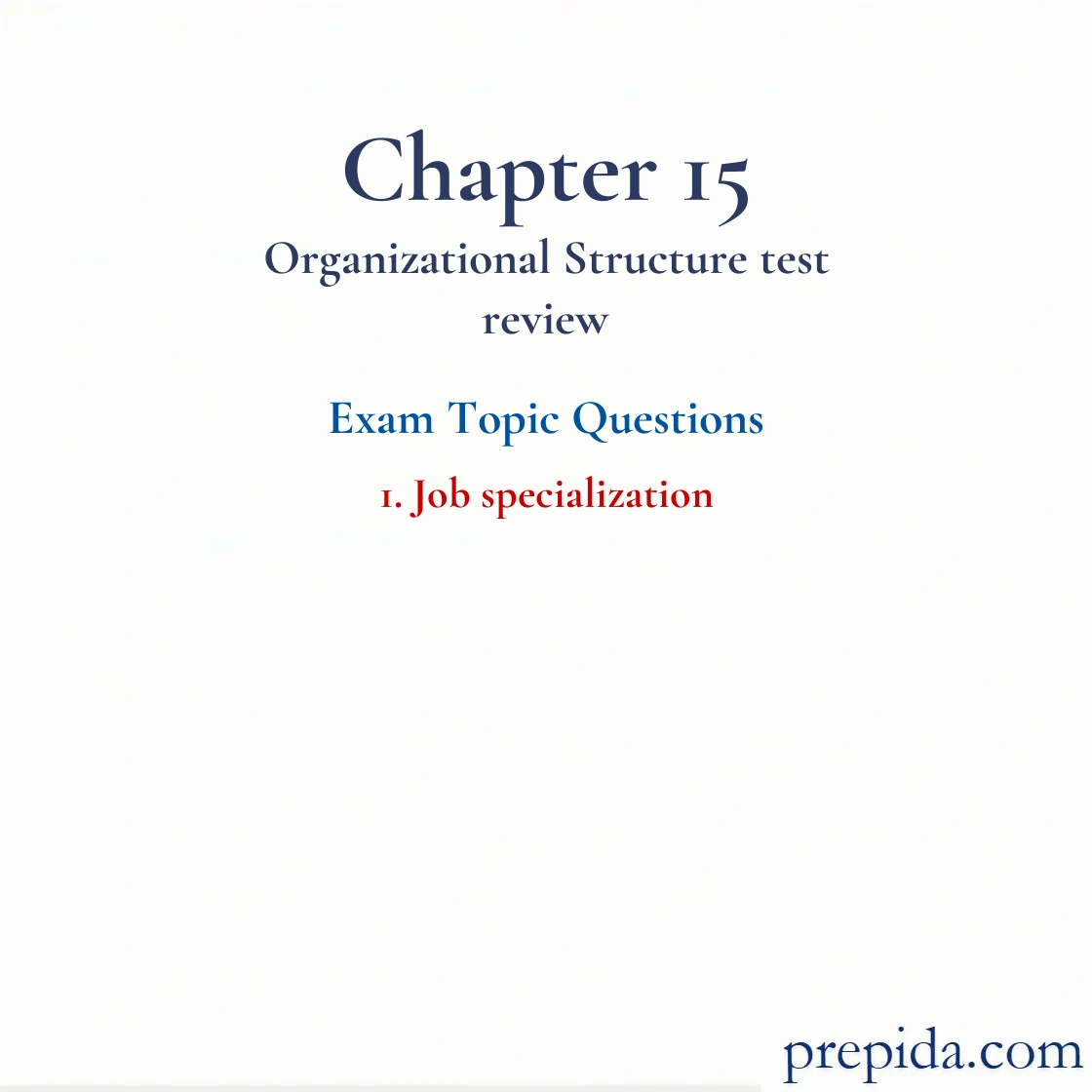
The degree to which a job requires a number of different activities involving a number of different skills and talents is referred to as
- task identity.
- variety.
- task significance.
- autonomy.
- feedback.
Variety is the degree to which a job requires a number of different activities involving a number of different skills and talents.
Variety: The degree to which a job requires different activities and skills.
Work specialization refers to
- where decisions are formally made in organizations.
- the degree to which tasks in an organization are divided into separate jobs.
- how many employees each manager in the organization has responsibility for.
- answering the question of "who reports to whom?" and signifies formal authority relationships.
- the degree to which rules and procedures are used to standardize behaviors and decisions in an organization.
Work specialization is the way in which tasks in an organization are divided into separate jobs.
Work Specialization: The degree to which tasks in an organization are divided into separate jobs.
When looking at Wonder Guard Industries' organizational structure, Janice spots a heading for work specialization, which is also commonly referred to as
- formalization.
- centralization.
- span of control.
- division of labor.
- chain of command.
Work specialization is the way in which tasks in an organization are divided into separate jobs. In some organizations, this categorization is referred to as a company's division of labor.
Organizational Structure: Formally dictates how jobs and tasks are divided and coordinated between individuals and groups within the company.
Which of the following is True about work specialization?
- It creates problems in larger firms where little flexibility is required.
- It makes training new employees easier when replacements are needed.
- It encourages employees to upgrade their skills in multiple disciplines.
- It improves the flexible nature of workers.
- It ensures that each worker performs different tasks every day.
Work specialization is the way in which tasks in an organization are divided into separate jobs. It makes training new employees easier, but employees become less flexible and fail to update skills in other areas, and it creates more problems in smaller firms.
Work Specialization: The degree to which tasks in an organization are divided into separate jobs.
Employees tend to be more satisfied with jobs that require them to perform a specialized kind of activity.
Organizations may struggle with employee job satisfaction when they make jobs highly specialized. Employees tend to be more satisfied with jobs that require them to perform a number of different kinds of activities.
Shane is the project manager of the organizational development team at Solid Hardwoods. Shane's team has been assigned the task of studying and evaluating Solid Hardwoods' organizational structure. Shane divided the tasks among the team members to collect preliminary information on different elements of Solid Hardwoods' structure. Meg was asked to collect information on the degree to which tasks are divided into separate jobs. Andrea was asked to collect information on formal authority relationships. Francine started looking into how many employees each manager has responsibility for, and Carol was asked to collect evidence on the degree to which rules and procedures are used to standardize behaviors at Solid Hardwoods. Shane decided to personally collect information and evidence on where exactly decisions are formally made at Solid Hardwoods. The team decided to meet with information in two weeks. On which element of organizational structure was Carol asked to collect evidence?
- centralization
- formalization
- span of control
- chain of command
- work specialization
The degree to which rules and procedures are used to standardize behaviors and decisions in an organization refers to formalization. It is a coordination mechanism that organizations rely on to get a standardized product or deliver a standardized service.
Formalization: The degree to which rules and procedures are used to standardize behaviors and decisions in an organization.
At Buddy's Bird Barn, every employee has to consult Buddy before completing any sale, and only Buddy can make decisions about purchasing and advertising. These rules represent ________ at Buddy's Bird Barn.
- specialization
- centralization
- formalization
- span of control
- chain of command
Centralization reflects where decisions are formally made in organizations. If only the top managers within a company have the authority to make final decisions, we would say that the organization has a highly "centralized" structure. In contrast, if decision-making authority is pushed down to lower-level employees and these employees feel empowered to make decisions on their own, an organization has a "decentralized" structure.
Centralization: Refers to where decisions are formally made in organizations.
The managers at Microfab meet and realize that they have huge costs associated with training new employees, difficulty finding someone who can take the place of lost employees, and lower productivity than they would prefer from each employee. What can they do to address this issue?
- decrease the amount of control managers have over employees
- decrease the number of tasks each employee performs
- increase the number of tasks each employee performs
- increase the number of employees under each manger
- train the new employees themselves
Work specialization is the way in which tasks in an organization are divided into separate jobs. Having only one task to perform allows employees to be extremely productive at doing that one thing. It also means that training new workers is much easier when replacements were needed.
Training: A systematic effort by organizations to facilitate the learning of job-related knowledge and behavior.
Henry Ford was a strong believer in work specialization.
Henry Ford was perhaps the earliest (and clearly most well-known) believer in high degrees of work specialization.
Work Specialization: The degree to which tasks in an organization are divided into separate jobs.